|
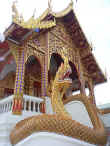 Apr. 15-21, 1999 Chang Mai and
Hill Tribe Trek, North Thailand Apr. 15-21, 1999 Chang Mai and
Hill Tribe Trek, North Thailand"Excuse me, is there
something you know that we don't?" I ask one of our four evident new 'boat mates'
standing with us on the floating dock, waiting for our longtail boat driver to drift aside
the platform and pick us up.
"What?"
"I said, is there something you know that we don't?" this time pointing
to he and his traveling companion's backpacks, laying beside them and wrapped tight with
clear plastic in an apparent effort to waterprotect the contents.
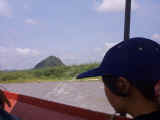 "Uh, maybe" he replies with some
surprise, "I just read in my guidebook that our path to Chang Rai takes us through a
few good rapids" he informs me in excellent English, although through a thick German
accent. "It says this ride can get a little wet". "Uh, maybe" he replies with some
surprise, "I just read in my guidebook that our path to Chang Rai takes us through a
few good rapids" he informs me in excellent English, although through a thick German
accent. "It says this ride can get a little wet".
Well, I think to myself as our boat pulls up, that'd be a great way to start our
trek into the northern hills of Thailand - with sopping underwear! And socks, shorts,
shirts, and everything else for that matter.
"There's something else" he says.
"Yes"
"Good stuff, they call it sunscreen" he says, half sarcastically.
"Ju'd read about that in your guidebook too?" I ask, just to have the
last smart-aleck word in.
 And so, Laura with queasy stomach, and I with
unsettled mind, we load our bags and CAREFULLY climb into the long, narrow,
low-to-the-water, (and rocking) craft that the Thais have lovingly dubbed hong yao, or
'longtail'. Its name comes from the 6 feet long axle pole, sprouting backwards from the
engine and blossoming into a prop. It's designed so it can be raised or lowered to
navigate any particularly shallow waterways. But hopefully we won't hit too many areas
that are that shallow, for the six of us, our luggage, and our 250 pound driver, drop the
edges of the craft down to near water level. And so, Laura with queasy stomach, and I with
unsettled mind, we load our bags and CAREFULLY climb into the long, narrow,
low-to-the-water, (and rocking) craft that the Thais have lovingly dubbed hong yao, or
'longtail'. Its name comes from the 6 feet long axle pole, sprouting backwards from the
engine and blossoming into a prop. It's designed so it can be raised or lowered to
navigate any particularly shallow waterways. But hopefully we won't hit too many areas
that are that shallow, for the six of us, our luggage, and our 250 pound driver, drop the
edges of the craft down to near water level.
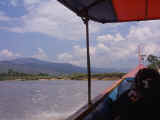 We shove off and quickly reach 'crusin'' speed. The jungled
banks of the Kok River whiz by with our wake. Along the way, we pass a few fishermen
wading in the water - their nets in hand, and small groups of children jumping from rocks
- their shorts in hand. Arrangements of small, thatched huts occasionally interrupt the
lines of lush green vegetation zipping by us along both banks. We shove off and quickly reach 'crusin'' speed. The jungled
banks of the Kok River whiz by with our wake. Along the way, we pass a few fishermen
wading in the water - their nets in hand, and small groups of children jumping from rocks
- their shorts in hand. Arrangements of small, thatched huts occasionally interrupt the
lines of lush green vegetation zipping by us along both banks.
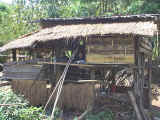 Very out of place, I'm surprised to see what looks like
a large sign popping from the water by the left bank. As we get closer, I can begin to
make out the letters. It reads: Severe rapids ahead. Remove craft and walk around. Hum,
maybe our German friend was right after all. We'll soon find ooouuut! Splash! Plash!
Swash! Splash! Fortunately, our driver demonstrates his skill by getting us through the
roughest sections, soaking wet, but still afloat. No harm, no foul, our backpacks are
still relatively dry, and besides, the dousing feels kinda' nice on this hot, balmy Thai
afternoon. Very out of place, I'm surprised to see what looks like
a large sign popping from the water by the left bank. As we get closer, I can begin to
make out the letters. It reads: Severe rapids ahead. Remove craft and walk around. Hum,
maybe our German friend was right after all. We'll soon find ooouuut! Splash! Plash!
Swash! Splash! Fortunately, our driver demonstrates his skill by getting us through the
roughest sections, soaking wet, but still afloat. No harm, no foul, our backpacks are
still relatively dry, and besides, the dousing feels kinda' nice on this hot, balmy Thai
afternoon.
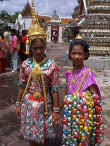 After
arriving and spending yesterday in Chang Rai, (attending to such small details such as
finding a guide for our trek into the hills), this morning has us up bright and early and
waiting for our driver. After
arriving and spending yesterday in Chang Rai, (attending to such small details such as
finding a guide for our trek into the hills), this morning has us up bright and early and
waiting for our driver.
"Hello, my name is Homee" he tells us when they arrive, hand stretched
out and a beam as wide as Buddha's.
"Hello. I'm Scott and this is Laura. Nice to meet you. By the way, did they
tell you that we're looking for non-tourists places, sort of off the beaten track?"
"Yes, yes, I know. No other tourists. Remote villages. No problem."
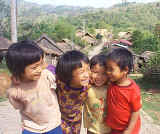 Next thing we know, we're deep in the north
hills, riding atop a large lumbering pachyderm, leaning sideways to avoid being swatted in
the face by a 'low-hanging' branch sticking out about 12 feet above the trail. And sure
enough, true to Homee's word, there isn't another tourist in sight. The few people that we
do see, as we bounce bop and rock back and forth along the trail, are hill tribe clansfolk
planting new, and tending to existing, crops along the slopes. Occasionally, they look up
from their back-breaking labor to watch us slowly trod past. For the native Thais, I
suppose the sight of an elephant sauntering along on a nearby path is a rather normal one.
But for those us who are visitors, the experience of riding atop one is anything but
normal. Next thing we know, we're deep in the north
hills, riding atop a large lumbering pachyderm, leaning sideways to avoid being swatted in
the face by a 'low-hanging' branch sticking out about 12 feet above the trail. And sure
enough, true to Homee's word, there isn't another tourist in sight. The few people that we
do see, as we bounce bop and rock back and forth along the trail, are hill tribe clansfolk
planting new, and tending to existing, crops along the slopes. Occasionally, they look up
from their back-breaking labor to watch us slowly trod past. For the native Thais, I
suppose the sight of an elephant sauntering along on a nearby path is a rather normal one.
But for those us who are visitors, the experience of riding atop one is anything but
normal.
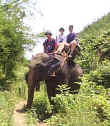 High on the elephant's back, we're perched upon (and
gripping tightly to) a platform that's strapped around his tail, belly, and neck. All we
can do is hold tight and hope the knots stay fast as he navigates down into steep ravines,
and then up along sheer sloping hillsides. Sometimes pausing in-between for a quick,
'refreshing shower' (for all of us) of creek water and elephant phlegm. Burroouugh!
Fittissshhh! I wipe off my face and think - it's amazing how much water that trunk can
hold! High on the elephant's back, we're perched upon (and
gripping tightly to) a platform that's strapped around his tail, belly, and neck. All we
can do is hold tight and hope the knots stay fast as he navigates down into steep ravines,
and then up along sheer sloping hillsides. Sometimes pausing in-between for a quick,
'refreshing shower' (for all of us) of creek water and elephant phlegm. Burroouugh!
Fittissshhh! I wipe off my face and think - it's amazing how much water that trunk can
hold!
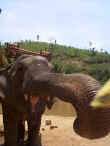 As we move on, I'm also amazed at how
narrow and rocky a path those huge round feet are able to so gracefully navigate. After
gingerly stepping through a particularly challenging stretch like this one, we usually
reward our hard-working carrier's efforts with a special treat of sugar cane stalks or
bananas. "Here ya go boy! Like that? Good, how 'bout a few bananas?" It's all in
a day's work for our water-spewing, floppy-eared, long-trunked new buddy. As we move on, I'm also amazed at how
narrow and rocky a path those huge round feet are able to so gracefully navigate. After
gingerly stepping through a particularly challenging stretch like this one, we usually
reward our hard-working carrier's efforts with a special treat of sugar cane stalks or
bananas. "Here ya go boy! Like that? Good, how 'bout a few bananas?" It's all in
a day's work for our water-spewing, floppy-eared, long-trunked new buddy.
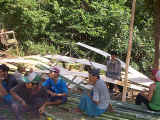 Our elephant friend takes a well deserved rest as we
spend the remainder of the day leaving boot tracks, instead of hoof prints, along the
dusty trail. On our way through one of the villages, we stop to watch the men of the tribe
build a house for the village's new school teacher. It's remarkable what the trained hand
can do with a few simple canes of bamboo. A quick chat with the teacher, a tour of the
small schoolhouse, and we're back on our way to our next stop. Our elephant friend takes a well deserved rest as we
spend the remainder of the day leaving boot tracks, instead of hoof prints, along the
dusty trail. On our way through one of the villages, we stop to watch the men of the tribe
build a house for the village's new school teacher. It's remarkable what the trained hand
can do with a few simple canes of bamboo. A quick chat with the teacher, a tour of the
small schoolhouse, and we're back on our way to our next stop.
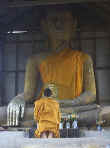 It's a hour or two down the trail, under what seems to
be a randomly chosen group of shade trees, that our guide Homee motions us close and
begins telling us stories of life in the hill tribes. At this point, his real personality
begins to show itself. Bright twinkle in his eye and almost constant chuckle in his voice,
he rants on and on, using quip, example, and antidote to give us the real scoop on sex,
religion, and politics, in a typical northern Thai village. An all-around jolly fellow,
Homee enjoys peppering his tales with jokes that he finds particularly humorous and
entertaining. And they are, but not nearly as entertaining as the sound of his
self-induced laughter after he tells us one. It's a hour or two down the trail, under what seems to
be a randomly chosen group of shade trees, that our guide Homee motions us close and
begins telling us stories of life in the hill tribes. At this point, his real personality
begins to show itself. Bright twinkle in his eye and almost constant chuckle in his voice,
he rants on and on, using quip, example, and antidote to give us the real scoop on sex,
religion, and politics, in a typical northern Thai village. An all-around jolly fellow,
Homee enjoys peppering his tales with jokes that he finds particularly humorous and
entertaining. And they are, but not nearly as entertaining as the sound of his
self-induced laughter after he tells us one.
|



